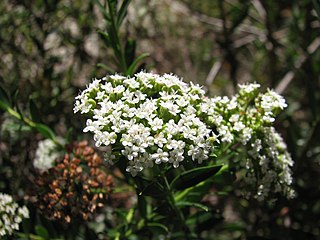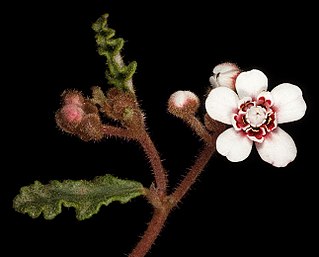
Commersonia is a genus of twenty-five species of flowering plants in the family Malvaceae. Plants in this genus are shrubs or trees, occurring from Indochina to Australia and have stems, leaves and flowers covered with star-like hairs. The leaves are simple, often with irregularly-toothed edges, the flowers bisexual with five sepals, five petals and five stamens and the fruit a capsule with five valves. The genus underwent a revision in 2011 and some species were separated from Commersonia, others were added from Rulingia.

Chamelaucium, also known as waxflower, is a genus of shrubs endemic to south western Western Australia. They belong to the myrtle family Myrtaceae and have flowers similar to those of the tea-trees (Leptospermum). The most well-known species is the Geraldton Wax, Chamelaucium uncinatum, which is cultivated widely for its large attractive flowers.

Gastrolobium is a genus of flowering plants in the family Fabaceae. There are over 100 species in this genus, and all but two are native to the south west region of Western Australia.

Mirbelia is a plant genus belonging to the family Fabaceae. It is endemic to Australia, occurring in every mainland state except South Australia.

Thomasia is a genus of thirty-one species of flowering plants in the family Malvaceae. Plants in this genus are small shrubs that are endemic to the south-west of Western Australia, apart from P. petalocalyx that is native to Victoria and South Australia. The leaves are simple with leaf-like stipules at the base of the petiole, the flowers bisexual with five papery, petal-like sepals, usually five petals and five stamens opposite the petals. The fruit is a capsule covered with star-like hairs.

Thryptomene is a genus of small shrubs in the family Myrtaceae described as a genus in 1838. The entire genus is endemic to Australia.

Platysace is a genus of woody perennial herbs and subshrubs in the family Apiaceae. The genus is endemic to Australia.

Hypocalymma is a genus of evergreen shrubs in the myrtle family Myrtaceae described as a genus in 1840. The entire genus is endemic to southern Western Australia.

Phebalium is a genus of thirty species of shrubs or small trees in the family Rutaceae and is endemic to Australia. The leaves are arranged alternately, simple and often warty, the flowers arranged singly or in umbels on the ends of branchlets or in leaf axils, usually with five sepals, five petals and ten stamens. There are about thirty species and they are found in all Australian states but not in the Northern Territory.

Billardiera is a genus of small vines and shrubs in the family, Pittosporaceae, which is endemic to Australia. The genus was first formally described in 1793 by botanist James Edward Smith who named it in honour of Jacques Labillardière, a French botanist.

Daviesia, commonly known as Bitter-peas, is a large genus of flowering plants in the legume family. They are native to Australia, with a centre of diversity in Western Australia.

Calytrix is a genus of shrubs in the family Myrtaceae described as a genus in 1806. They are commonly known as starflowers. Calytrix are endemic to Australia, occurring in the.

Sphaerolobium is a genus of flowering plants in the family Fabaceae. The genus is endemic to Australia, occurring in all states and territories except the Northern Territory.
Triptilodiscus is a genus of flowering plants in the pussy's-toes tribe within the daisy family.

Ceratogyne is a genus of flowering plants in the daisy family.

Microcybe is a genus of plants in the family Rutaceae, all of which are native to Australia.

Rinzia is a genus of flowering plants in the family Myrtaceae. The genus was first formally described in 1843 and reinstated and revised in 1986. The entire genus is endemic to Western Australia.
Pericalymma is a group of plants in the myrtle family Myrtaceae described as a genus in 1840. The entire genus is endemic to Western Australia.
- Pericalymma crassipes(Lehm.) Schauer
- Pericalymma ellipticum(Endl.) Schauer
- Pericalymma megaphyllumCranfield
- Pericalymma spongiocauleCranfield

Androcalva pulchella is a shrub in the family Malvaceae. It is native to Western Australia.
Xerosollya is a genus of flowering plants belonging to the family Pittosporaceae.

















